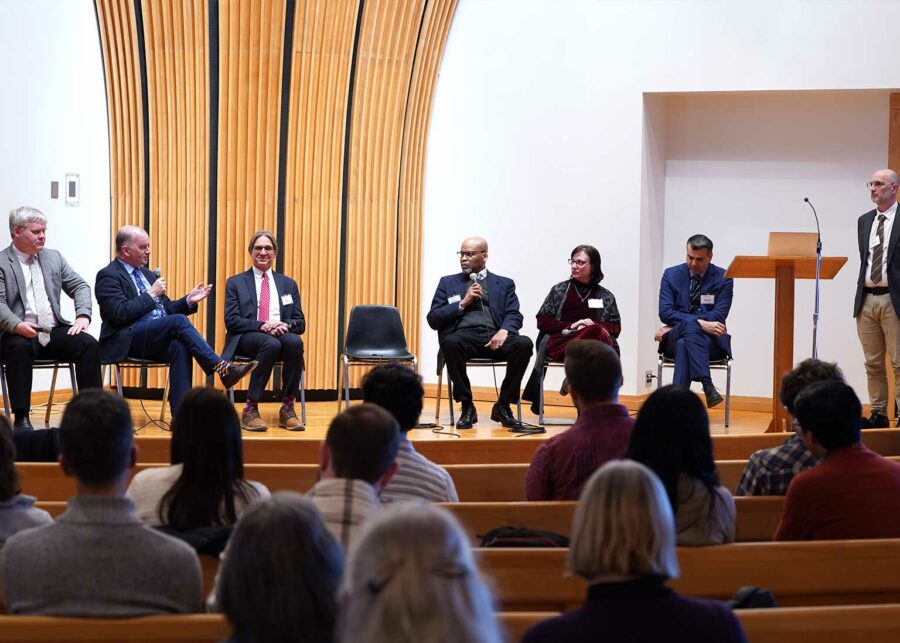Attentiveness: Unity, Again

“But don’t you think our divisions—Christian divisions, not just among Evangelicals—are our greatest problem?”
This was one of the most memorable questions asked at a conference on Evangelicalism this past week at Gordon-Conwell.[1] There were many themes that came up regarding the future of the movement, but I believe in the background of this discussion was the question of how we should respond to the deathly pollution from the larger society that is infiltrating and smothering the church. This cultural pollution shows itself in anger, divisions, and distrust that seem to have not just seeped into our churches, but in many ways have become part of the culture of our churches. Churches, as well as parachurch organizations and even Christian families, are so divided they have a hard time speaking the same language with the same meaning. We, as the community of faith, can do better because the church, as the Body of Christ, is (or ought to be) the answer to those problems through genuine reconciliation in Christ. The church should be a foretaste of Kingdom peace and unity, but instead we have been infected by the same insecurities and divisions and even the same anger as the larger culture. We are rife with church divisions. “Help us, Jesus.”
There were many answers that flooded my brain when that question was posed, but it wasn’t directed to me, so I cogitated and pondered.
My mind went back to studies in graduate school about the struggles for church unity that came out of the 19th century missionary movement, specifically to the great New York Ecumenical Missionary Conference of 1900. The title says it all: missionary (mostly fueled by evangelical theology and zeal) and ecumenical (Christians of all traditions must work as one for world evangelization). It was an iconic event for American Christianity. President McKinley presided over the opening ceremonies and former President Benjamin Harrison and Governor Theodore Roosevelt (a future president) participated. Even the President of Columbia University spoke: “What can Christians do better, in such a time as this, than to bear their unshaken testimony to their belief that there is no other Name under heaven, whereby men must be saved, but the Name of Jesus Christ?” This was the president of an Ivy League university in 1900! It was a different age when presidents of the United States, governors, and even university presidents supported evangelistic Christian mission to the unreached!
This was an unprecedented time of cultural Christian unity centered around global mission. Yet, alas, in the immediate aftermath of this remarkable conference fundamentalists were splitting from modernists in their respective responses to rapid social and cultural changes that were taking place. Thus, social gospel which Fundamentalism opposed.
So the unity displayed 1910 was but a fleeting reprieve. Within 10 years either side of the Conference the Pentecostal movement began (which caused many divisions even as it united others) and The Fundamentals were published, again, seeking to unite Christians around common fundamental doctrines in large part in opposition to higher criticism of the Bible.
The early work toward unity was called ecumenical work, and it developed around a common concern for global mission. This “evangelical” movement (meaning, gospel-centered) enjoyed great success for nearly a half a century. But eventually issues of church order and the place of church and society arose, further dividing the church.
And then my mind went back to my third PhD exam, which was on the history of the ecumenical movement. I remembered the struggle for global unity and the various approaches that were tried and that managed to keep churches together in discussion and cooperation. But the rising neo-evangelicals of the 1960s had started their own missions and organizations for unity, while the World Council of Churches became less ecumenical, less concerned about evangelism and church planting, and less representative of the growing churches in China, Africa and Latin America and the Caribbean.
Does this mean the possibility of church unity is hopeless? Or should we continue to pray along with Jesus in the High Priestly prayer “…that they may all be one; even as thou, Father, art in me, and I in thee, that they also may be in us, so that the world may believe that thou has sent me”? (John 17, RSV)
I think of the answer that was given by our guest speaker, Dr. Carl Trueman: “Well, it is hard to envision or work for unity in all the world, but I think each of us can and should work for greater unity among Christians in our own communities and in our cities.”
This is the conclusion that other groups have come to. We don’t need to agree on every doctrine, or on the liturgy, or on church order, or on eschatology, but we need to express Jesus-centered unity “in each place.” Evangelicals should pave the way for others. Our history is one of uniting people across denominations and across church polity in spiritual movements of renewal. We see this as the work of the Holy Spirit. I believe our local communities need to see such unity based on being guided in all of life by Holy Scripture, the salvation and lordship of Jesus Christ and accepting his mission. Here is how it was expressed 63 years ago:
“We believe that the unity which is both God’s will and His gift to his church is being made visible as all in each place who are baptized into Jesus Christ and confess him as Lord and Savior are brought by the Holy Spirit into a fully committed fellowship…”[2]
So, the issue of church unity and division is not new. But today it is a pervasive problem. Let’s be honest; such discord goes back to the disciples arguing about who is first, and Paul’s first letter to the Corinthians. But today, with the benefit of Holy Scripture and history, we can—and must–do better.
Let’s embrace our Christ-centered evangelical faith and spirituality while reaching out in prayer for a visible unity “in each place.” All this, so that the world may know.
[1] All of the addresses from the conference will soon be available on this website.
[2] 1961 Assembly of the World Council of Churches where the first two Pentecostal churches were admitted into membership (both from Chile).
 Dr. Scott W. Sunquist, President of Gordon-Conwell Theological Seminary, is author of the “Attentiveness” blog. He welcomes comments, responses, and good ideas.
Dr. Scott W. Sunquist, President of Gordon-Conwell Theological Seminary, is author of the “Attentiveness” blog. He welcomes comments, responses, and good ideas.